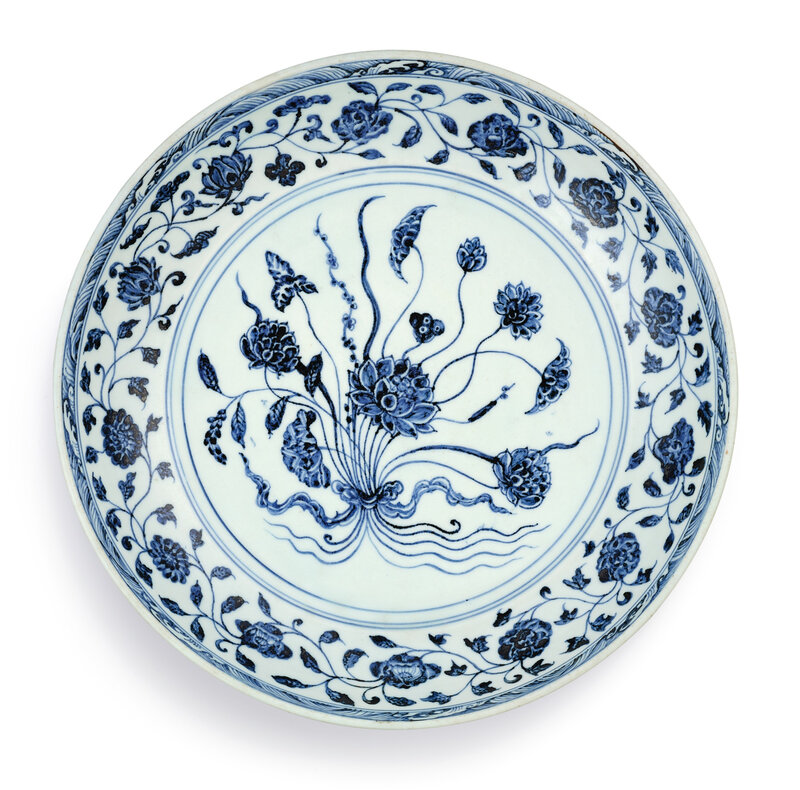with shallow rounded sides resting on a short gently tapered foot, superbly decorated on the interior in deep cobalt blue with a medallion enclosing a ribbon-tied bouquet of lotus flowers and leaves, arrowhead and other waterplants, the medallion encircled with a composite floral scroll of camellia, hibiscus, pomegranate, tree peony, rose, lotus and chrysanthemum, all repeated twice save for the pomegranate, all below a band of crashing waves bordering the rim, the exterior similarly decorated with a composite floral scroll, between a classic scroll band bordering the rim and a key-fret frieze above the foot, the foot encircled with a single-line border, the base left unglazed.
Provenance: Christie's London, 10th June 1974, lot 74.
Christie's London, 8th December 1975, lot 126.
Christie's London, 11th July 1977, lot 112.
Eskenazi Ltd, London, 1978, no. 8134.
Exhibited: Zhongguo taoci yaji/ An Anthology of Chinese Ceramics, Min Chiu Society, Hong Kong Museum of Art, Hong Kong, 1980, cat. no. 75
Note: Blue and white chargers of this shape and design represent the most classic decorative repertoire during the Yongle period. The lotus-bouquet motif, with its unexpected combination of lotus flowers, leaves and water weeds, tied with a ribbon, evokes strikingly coloured lotus ponds in full bloom during summer. Such design was often executed with slight variations on the rim which could vary between a wave, classic scroll or key-fret border. Compare a similar charger rendered in this design from the National Palace Museum, Taipei, included in the Museum’s exhibition Shi yu xin: Mingdai Yongle huangdi de ciqi/Pleasingly Pure and Lustrous: Porcelains from the Yongle Reign (1403-1424) of the Ming Dynasty, Taipei, 2017, p. 67.
These dishes or chargers were made popular and were widely exported to the Middle East with the expansion of trade routes during the Yongle reign, as demonstrated by the abundance of such examples in the Middle Eastern collections. See a dish illustrated in Regina Krahl and John Ayers, Chinese Ceramics in the Topkapi Saray Museum, Istanbul, London, 1986, vol. II, no. 604; and thirty-four dishes of varying sizes decorated with the lotus-bouquet design recorded in the Ardabil Shrine, Iran, illustrated in John Alexander Pope, Chinese Porcelains from the Ardebil Shrine, Washington, D.C., 1956, pls 30 and 31.
The design was revived again by the imperial kilns during the Yongzheng and Qianlong periods of the Qing dynasty; compare three revival dishes in the Palace Museum, Beijing, illustrated in Geng Baochang, ed., Gugong Bowuyuan cang Ming chu qinghua ci [Early Ming blue-and-white porcelain in the Palace Museum], Beijing, 2002, vol. II, pls 195, 199 and 203.
For an early version of this motif, see a Cizhou octagonal pillow carved in the sgraffiato technique, from the Manno Art Museum, sold at Christie’s Paris, 19th November 2003, lot 224.
Sotheby's. Important Chinese Art from the Collection of Sir Quo-Wei Lee II, Hong Kong, 08 Oct 2019

/https%3A%2F%2Fprofilepics.canalblog.com%2Fprofilepics%2F1%2F0%2F100183.jpg)
/https%3A%2F%2Fstorage.canalblog.com%2F03%2F02%2F119589%2F96711876_o.jpg)
/https%3A%2F%2Fstorage.canalblog.com%2F11%2F31%2F119589%2F94773502_o.jpg)
/https%3A%2F%2Fstorage.canalblog.com%2F20%2F83%2F119589%2F94772815_o.jpg)
/https%3A%2F%2Fstorage.canalblog.com%2F26%2F72%2F119589%2F75604929_o.jpg)
/https%3A%2F%2Fstorage.canalblog.com%2F59%2F60%2F119589%2F26458628_o.jpg)





/image%2F1371349%2F20240416%2Fob_2a8420_437713933-1652609748842371-16764302136.jpg)
/image%2F1371349%2F20240414%2Fob_83ee65_2024-nyr-22642-0954-000-a-blue-and-whi.jpg)
/image%2F1371349%2F20240414%2Fob_15808c_2024-nyr-22642-0953-000-a-blue-and-whi.jpg)
/image%2F1371349%2F20240414%2Fob_e54295_2024-nyr-22642-0952-000-a-rare-blue-an.jpg)